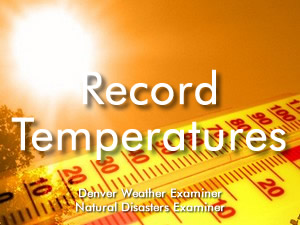
There was little doubt that last month was a wet one and now that May 2011 has come to a close we can see that it certainly was. In fact, it was one of the wettest Mays on record and also one of the coldest.
Up until the last few days of the month it looked like we were going to make the top 10 list for coldest Mays on record. But, thanks to a few near-normal days, our average temperature for the month ended at 53.1 degrees. This fell just short of the number 10 spot on the list of 53.0 degrees recorded in 1950.
Nevertheless the month’s average temperature was 4.1 degrees below the normal of 57.2 degrees. Our warmest temperature of the month of 86 degrees was recorded on both the 7th and the 8th and those were two of only three days with temperatures above 80 degrees.
On the low end the coldest temperature was seen on the 5th when the mercury dropped to 28 degrees. This is also the last time we saw a temperature at or below freezing and will almost certainly be the last for the 2010 – 2011 winter season. Coincidentally, May 5th is the average date of our last freeze so we were right on the mark this year.
Here in Thornton we saw an average temperature of 52.9 degrees. Our warmest temperature was 86.8 degrees and our coldest 29.2 degrees.
May brought an abundance of precipitation eliciting many jokes about Denver having swapped locations with Seattle. In all, 4.79 inches of moisture was recorded at Denver International Airport during the month putting it in the books as the 7th wettest May on record. This was 2.47 inches above the May average of 2.32 inches.
Here in Thornton we recorded nearly an inch of precipitation more than what was recorded at DIA. ThorntonWeather.com saw 5.67 inches fall into our bucket for the month.
On average we record 1.3 inches of snow in May but last month continued the trend we saw all winter of a severe lack of snowfall. Only 1.0 inch of the white stuff was recorded at DIA and most of the metro area saw nothing during the month (including Thornton).
Given that it is highly unlikely June will bring any snow to Denver, the 2010 to 2011 season will wrap up with only 22.8 inches of snow – far below the 61.7 inches average. This will put the season into the history books as the 2nd least snowiest snow season on record. Only the 1888 to 1889 season saw less with 21.3 inches.
Thornton actually fared worse throughout the entire snow season and we are going to wrap it up with a paltry 21.2 inches.

 June is historically Denver’s severe weather month and severe thunderstorms, tornadoes and hail are notorious visitors to Denver and across eastern Colorado during the month.
June is historically Denver’s severe weather month and severe thunderstorms, tornadoes and hail are notorious visitors to Denver and across eastern Colorado during the month.



 February 2011 in the Mile High City was a relatively uneventful one. Temperatures were below normal and we received less snow and precipitation than what is typical for the month.
February 2011 in the Mile High City was a relatively uneventful one. Temperatures were below normal and we received less snow and precipitation than what is typical for the month. Colorado’s weather is notoriously fickle capable of dispensing an entire gamut of weather in a very short period of time. The month of March typifies this as we can see everything from major snowstorms and bitter cold to summer-like temperatures and tornadoes.
Colorado’s weather is notoriously fickle capable of dispensing an entire gamut of weather in a very short period of time. The month of March typifies this as we can see everything from major snowstorms and bitter cold to summer-like temperatures and tornadoes.